El astillero italiano Overmarine ha empleado casi dos años, numeroso personal experimentado, la más moderna tecnología y toda su experiencia para poder poner en el agua el nuevo “Da Vinci”, unidad número once de su modelo Mangusta 165
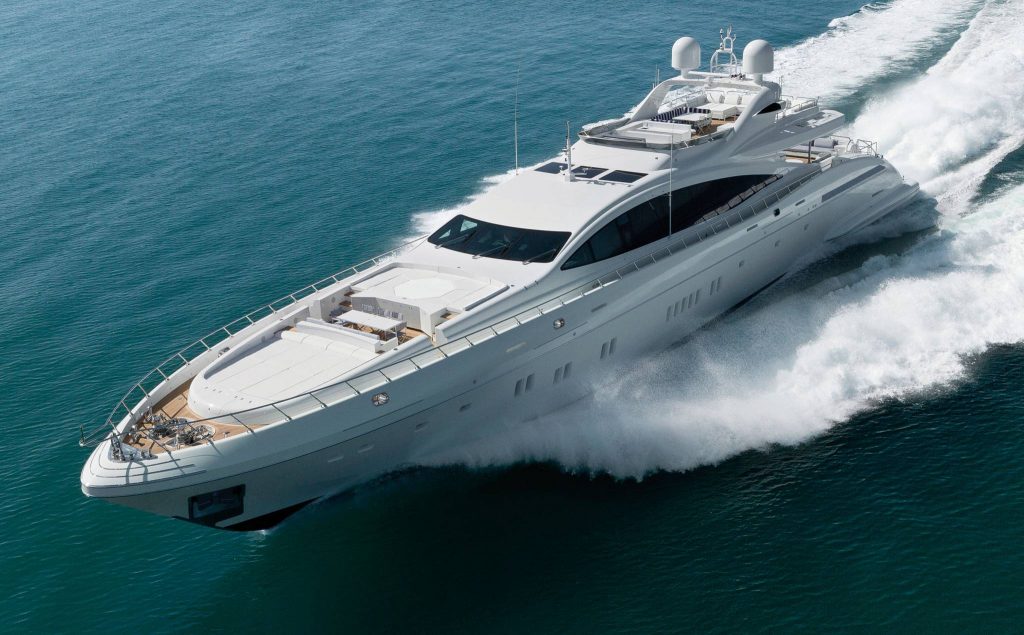
Los dos aspectos en los que este Mangusta 165 destaca frente a otros megayates de eslora similar son el espacio disponible y sus prestaciones. En cuestión de espacio, cabe decir que el “Da Vinci” es comparable a un yate del mismo tamaño, pero de 3 cubiertas. Y con respecto a sus prestaciones, el astillero italiano afirma que este Mangusta es el yate de esta eslora más rápido del mundo de los construidos en serie ya que, a pesar de sus 165 pies y su desplazamiento, llega a alcanzar una velocidad superior a 35 nudos, todo ello con cero vibraciones y bajísimos niveles de rumorosidad. Otro dato a tener en cuenta es su autonomía, que se sitúa en torno a las 600 millas náuticas gracias a los 40.000 litros que almacenan sus tanques de combustible.
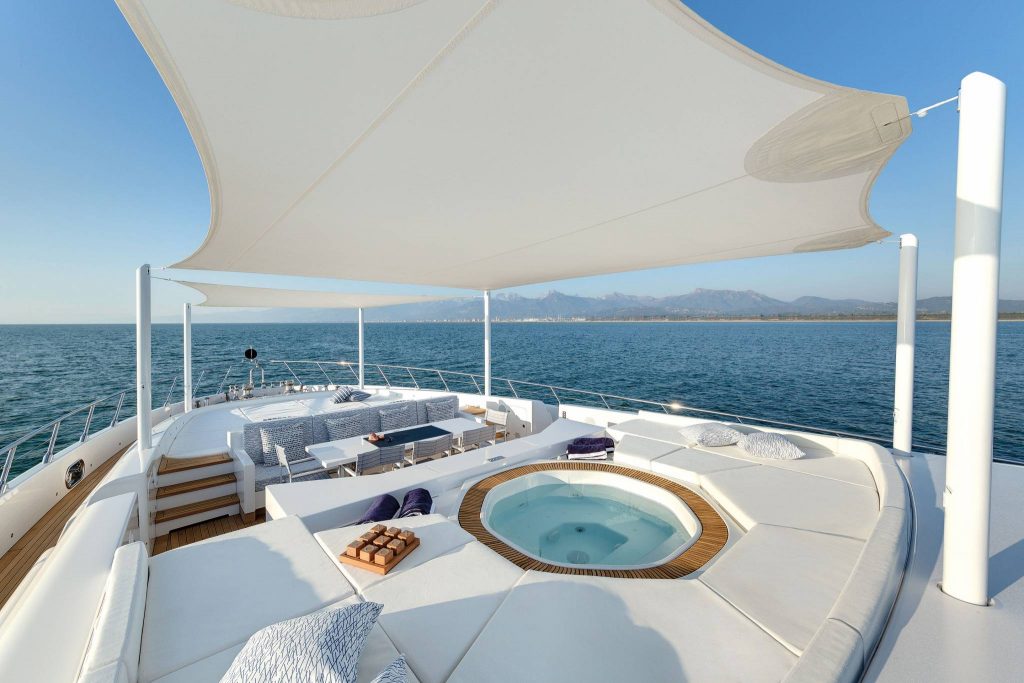
Tanto la superestructura de este superyate semicustom como su casco de planeo se han construido en GRP. Éste ha sido además dotado de cuatro estabilizadores Seakeeper que reducen los niveles de consumo considerablemente y optimizan la navegación en todas las condiciones, especialmente a velocidades bajas, haciendo posible la navegación en modo desplazamiento a velocidades más baja, de 8 a 10 nudos, y aumentando considerablemente la estabilidad cuando el Mangusta 165 se encuentra fondeado y amarrado.
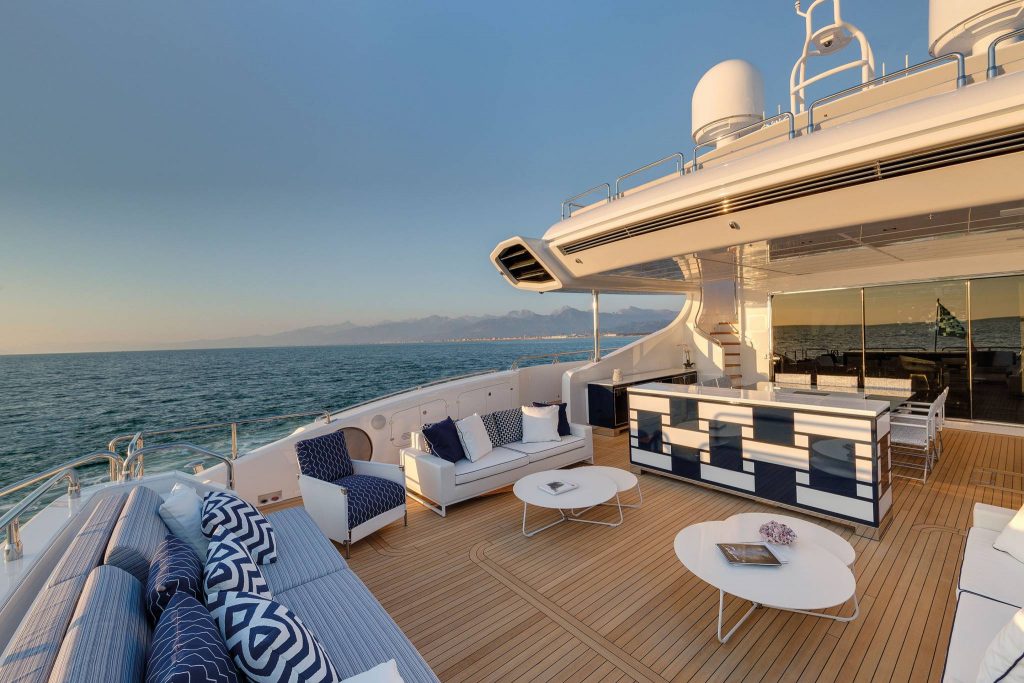
Últimas tendencias
Pero este Mangusta 165 no solo destaca por los aspectos puramente técnicos sino también por su apariencia, por sus líneas agresivas y deportivas que transmiten sensación de fuerza. En ellas también encontramos las últimas tendencias estéticas y estructurales introducidas por el astillero en otros modelos de su serie “Evolution”, relativas sobre todo a los nuevos acristalamientos y a la presencia de un flybridge alargado por popa, que en cierta forma evoca un diseño propio del automovilismo.
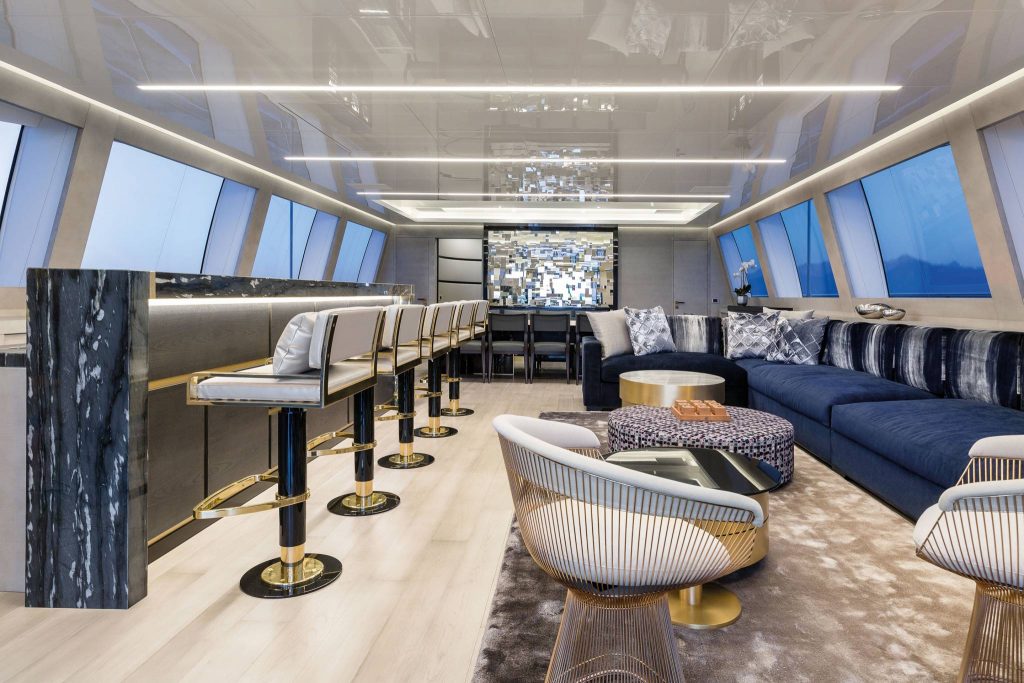
Alma sofisticada
Cómo todos los yates de Mangusta, la distribución y la decoración de los interiores del “Da Vinci” han sido personalizados para adaptarse en la medida de lo posible a los requerimientos de sus propietarios. Esta importante misión ha sido encomendada a la interiorista Maxine Tissenbaum, que ya había colaborado en otras ocasiones con el astillero italiano. Los puntos fundamentales en los que ha incidido la diseñadora canadiense han sido: los materiales de altísima calidad y difieren en los distintos ambientes; la atención prestada a los detalles; y su “alma” realmente sofisticada. No cabe duda de que el “Da Vinci” ofrece la comodidad y el lujo que requieren sus invitados, los cuales pueden disfrutar de numerosas áreas privadas y sociales tanto interiores como exteriores. Los materiales elegidos son esencialmente madera natural en diferentes tonos de gris para el piso y tonos similares para las paredes y los muebles, así como exquisito mármol y metales pulidos.
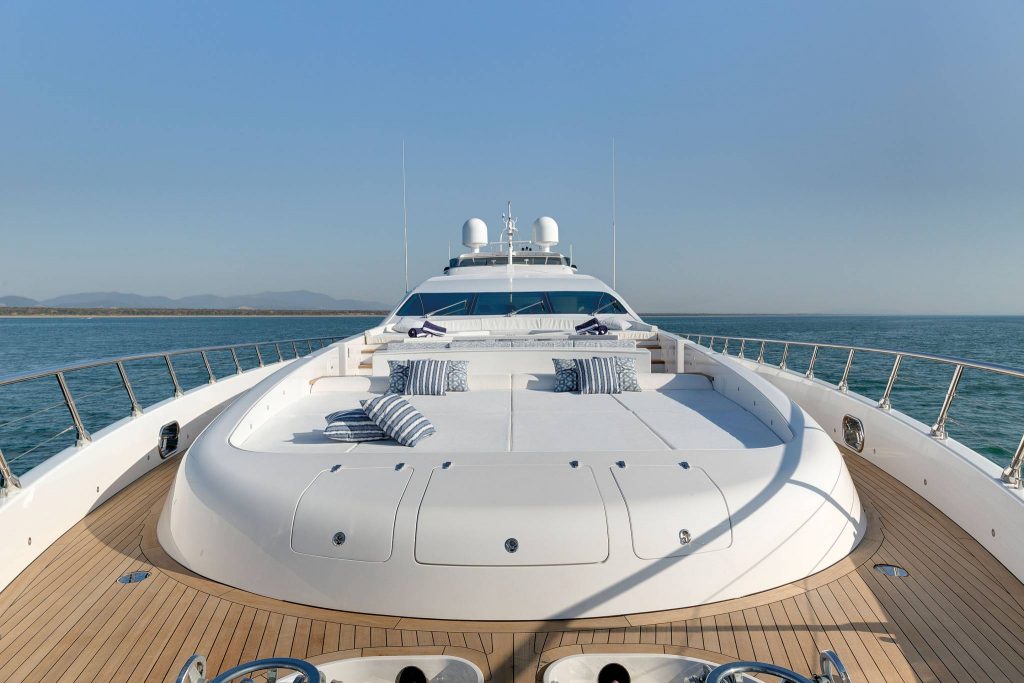
Del mobiliario destacaremos las dos grandes alacenas de madera y vidrio negro que flanquean ambos lados de la entrada, así como el “mosaico” realizado a modo de puzzle con distintos tipos de mármol (zebrino negro, palissandro azulado y negro Marquina). También resalta en esta área la zona del bar que cuenta con taburetes altos, una generosa barra en mármol de zebrino negro y un funcional botellero instalado tras ella. Éste se ha dispuesto en la pared y presenta un práctico sistema que permite al usuario acceder con facilidad a cada botella. Cuando no está en uso, todo queda oculto, igual que la gran pantalla de televisión que queda escamoteada en el techo.
El comedor, por su parte, cuenta con una gran mesa de mármol de Marquina con capacidad para 12 comensales.Seguidamente, el salón, concebido como un espacio de encuentro y para conversar dispone de un gran sofá. En esta zona destaca la presencia de algunas piezas de mobiliario circular que otorgan un toque muy personal al ambiente. Un poco más a proa, el panel que separa el salón y el puesto de gobierno ha sido creado como una obra de arte en sí misma, como evidencian las puertas revestidas en valiosa piel Stingray en diferentes tonos de azul.
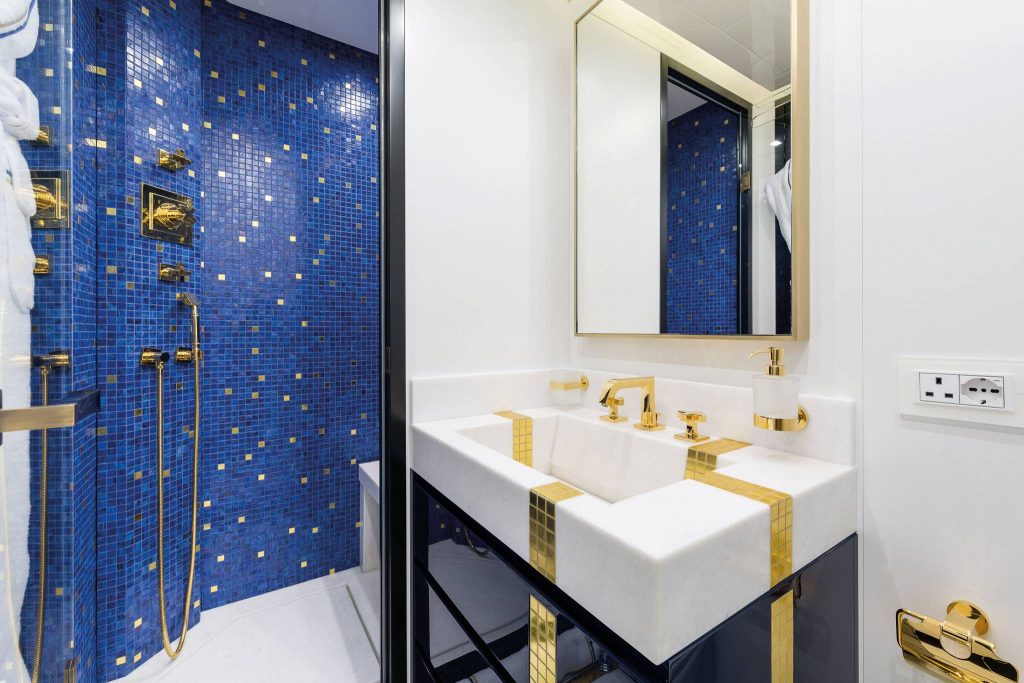
El puesto de gobierno, más a proa, cuenta con un gran acristalamiento en el techo diseñado especialmente para esta línea, mientras que para la consola se ha empleado fibra de carbono y piel. Madera, piel, carbono componen interesantes contrastes y armonías gracias al juego de colores y materiales. Como era de esperar, el puente de mandos equipa los controles de última generación de motores los MTU, además de la tecnología Rolls Royce/Kamewa waterjets y de los cuatro estabilizadores Seakeeper, algo muy apropiado en un superyate de alto rendimiento, fácilmente maniobrable y manejable.
La escalera central que conecta la zona social con la cubierta de descanso, ofrece un fuerte impacto visual con líneas horizontales y verticales en madera en color negro ceniza y los paneles cerrados en piel gris y nacarado.Ya en la cubierta inferior, el “Da Vinci” ofrece alojamiento a 12 invitados, distribuidos en 6 camarotes, incluyendo una suite principal para el armador, un camarote VIP, dos cabinas dobles, una cabina con dos camas y una con literas. Una escalera separada da acceso al área de servicio, donde se ha instalado la cocina, totalmente equipada con electrodomésticos de la línea profesional de la marca alemana Miele y que incluye, refrigerador, congelador y lavavajillas. Esta escalera también da acceso a un área para la tripulación, con su comedor, una cabina para el capitán y cuatros cabinas para la tripulación, pues este Mangusta 165 es capaz de albergar hasta 6 tripulantes a bordo, algo usual en un superyate de esta eslora.
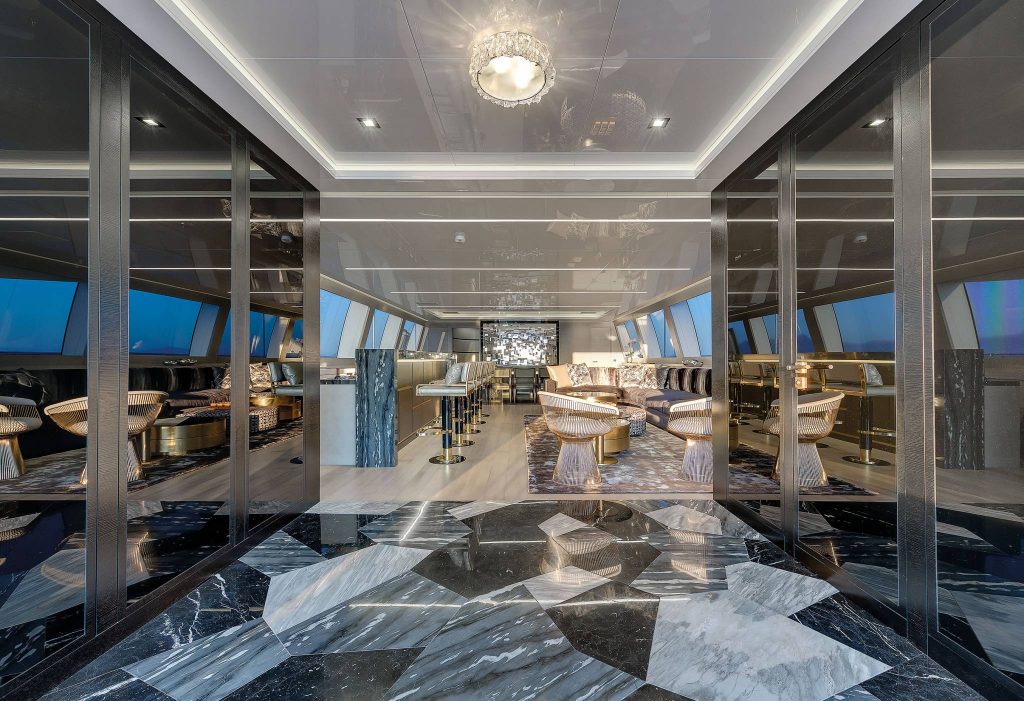
Áreas exteriores sorprendentes
Experimentar el mar al máximo con amigos y la familia y poder hacerlo de una manera versátil, teniendo la posibilidad de acceder a las distintas áreas disponibles para relajarse. Éste es un aspecto que siempre ha cuidado mucho el astillero italiano Overmarine y el “Da Vinci” no es una excepción. Para comenzar, su amplia bañera cuenta con un segundo comedor exterior que con capacidad para hasta 12 comensales bajo la protección del voladizo del fly. Tras esta amplia dinette se ha conformado una generosa zona de estar que cuenta con tres amplios sofás. Más a popa, un gran solárium deja libre dos accesos escalonados que dan paso a la generosa plataforma de baño. En proa, tras un inmenso solárium se ha creado un pequeño spa, con jacuzzi y zona de asiento. Toda esta zona puede quedar protegida del sol con un gran toldo. Pero los espacios desarrollados para disfrutar al máximo de la vida al aire libre no acaban ahí. El gran flybridge del “Da Vinci” brinda un amplio y despejado espacio, con solárium, zona de asiento, dinette, una barra sorprendente y el segundo puesto de gobierno, que queda perfectamente protegido por el parabrisas. De modo que no nos equivocamos al afirmar que a bordo del “Da Vinci” hay lujo, pasión y tecnología a partes iguales.
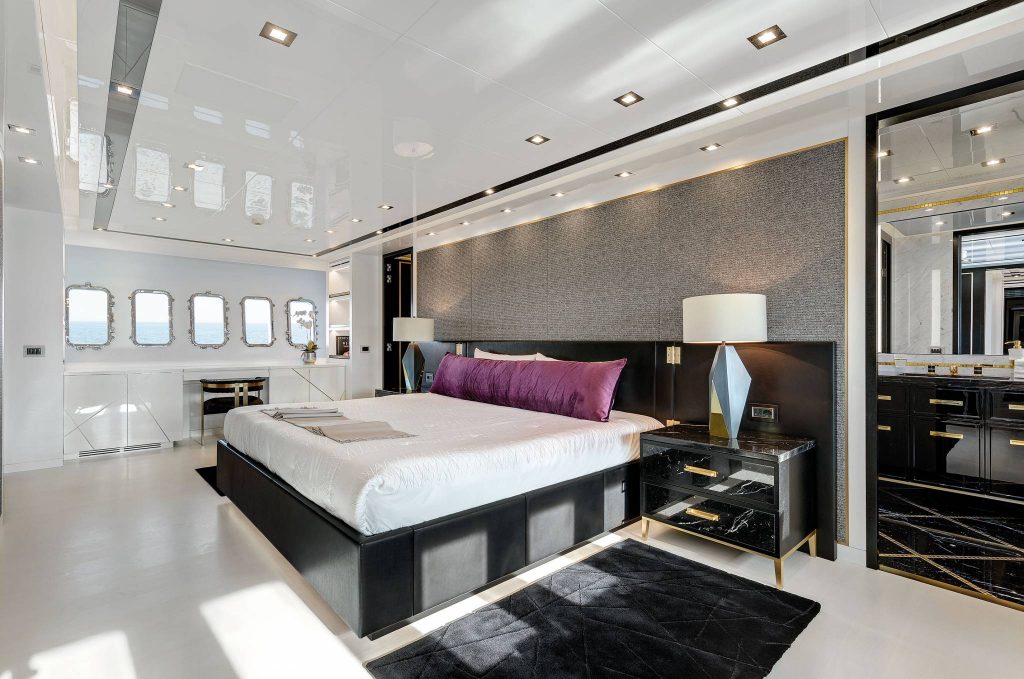
The Italian shipyard Overmarine has spent almost two years and used numerous experienced staff, the most modern technology and all its experience to put in the sea the new “Da Vinci”, the eleventh unit of its Mangusta 165 model.
The two aspects in which this Mangusta 165 stands out from other mega-yachts of similar length are the available space and its benefits. In a matter of space, it is possible to say that the “Da Vinci” is comparable to a yacht of the same size, but of 3 decks. And with regard to its performance, the Italian shipyard says that this Mangusta is the fastest yacht of the world of such length and of the series-produced ones because, despite its 165 feet and its displacement, it reaches a speed of more than 35 knots, all that with zero vibrations and very low-noise levels. Another point to consider is its autonomy, which is situated around 600 nautical miles thanks to the 40,000 litres that are stored in its fuel tanks.
Both the superstructure of this semicustom superyacht and its gliding hull have been built in GRP. It has also been equipped with four Seakeeper stabilizers which considerably reduce consumption levels and optimize navigation in all conditions, especially at low speeds, making possible navigation in shift mode at lower speeds, from 8 to 10 knots, and increasing stability when the Mangusta 165 is anchored and moored.
High sophistication
But this Mangusta 165 stands out, not only in the purely technical aspects, but also for its appearance, for its aggressive and sporty lines that convey a sense of strength. We also find in them the latest aesthetic and structural tendencies introduced by the shipyard in other models of its “Evolution” series, relating in particular to the new glazing and the presence of an elongated flybridge aft, which, in a way, evokes a design typical of the motor racing.
Sophisticated soul
As all Mangusta yachts, the distribution and decoration of the interiors of the “Da Vinci” have been customized to adapt as far as possible to the requirements of their owners. This important mission has been entrusted to the interior designer Maxine Tissenbaum, who had already collaborated on other occasions with the Italian shipyard. The fundamental points that have influenced the Canadian designer have been: the materials of the highest quality that differ in the different environments; attention to detail and its really sophisticated “soul”. There is no doubt that the “Da Vinci” offers the comfort and luxury that its guests require, who can enjoy numerous private and social areas both indoors and outdoors. The materials chosen are essentially natural wood in different shades of grey for the floor and similar shades for the walls and furniture as well as exquisite marble and polished metals. Among all the furniture, we will highlight two large wooden and black glass pantries that flank both sides of the entrance, as well as the “mosaic” made as a puzzle with different types of marble (black zebrino, blue palissandro and Marquina black). We also find in this area the bar with high bar stools, an ample bar in black zebrino marble and a functional bottle rack installed behind it. It is arranged on the wall and presents a practical system that allows the user to easily access each bottle. When it isn’t in use, everything is hidden, just like the large television screen that is hidden in the ceiling. The dining room, on its part, has a large Marquina marble table with capacity for 12 people. Then, the living room, conceived as a meeting space and for conversation, has a large sofa. In this area, the presence of some pieces of circular furniture is emphasized and gives a very personal touch to the environment. A little further forward, the panel that separates the salon and the government seat has been conceived as a work of art itself, as evidenced by the doors coated with valuable Stingray leather in different shades of blue. The wheelhouse, situated close to the bow, has a large glazing at the roof, especially designed for this line, while fibre and leather have been used for the console. Wood, leather and carbon create an interesting contrast and harmony, thanks to the combination of colours and materials. As expected, the navigation is equipped with the latest MTU engines, as well as the Rolls Royce / Kamewa waterjetsy technology of the four Seakeeper stabilizers, something very appropriate in a high performance superyacht, easily manoeuvrable and manageable. The central staircase that connects the social area with the resting deck offers a strong visual impact with horizontal and vertical lines in black-ash wood and the panels closed in grey and pearly leather. On the lower deck, the “Da Vinci” offers accommodation for 12 guests, distributed in 6 cabins, including a master suite for the owner, a VIP cabin, two double cabins, a cabin with two beds and one with bunk beds. A separate staircase gives access to the service area, where the kitchen has been installed, fully equipped with appliances of the German Miele brand and it includes refrigerator, freezer and dishwasher. This staircase also gives access to a crew area, with its dining room, a cabin for the captain and four crew cabins, as this Mangusta 165 can accommodate up to 6 crew members on board, something unusual in a superyacht of this length.
Amazing outdoor areas
Experiencing the sea to the maximum with friends and family and being able to do it in a versatile way, having the possibility of accessing the different available areas to relax. This is an aspect that has always been taken great care of by the Italian shipyard Overmarine and the “Da Vinci” is no exception. To begin with, its large bathtub has a second outdoor dining room that can accommodate up to 12 guests under the protection of the fly cantilever. Behind this large dinette, an ample living area has been formed and it has three large sofas. Close to the stern, a large solarium leaves two stepped accesses free which give way to the ample bathing platform. On the prow, behind a huge solarium a small spa has been created, with a jacuzzi and a seating area. This entire area can be protected from the sun with a large canopy. But the spaces developed to enjoy the best of outdoor life don’t end there. The large flybridge of the “Da Vinci” offers a wide and clear space, with solarium, seating area, dinette, an amazing bar and the second government seat, which is perfectly protected by the windscreen.So we are not wrong when we say that aboard the “Da Vinci” there is luxury, passion and technology in equal parts.
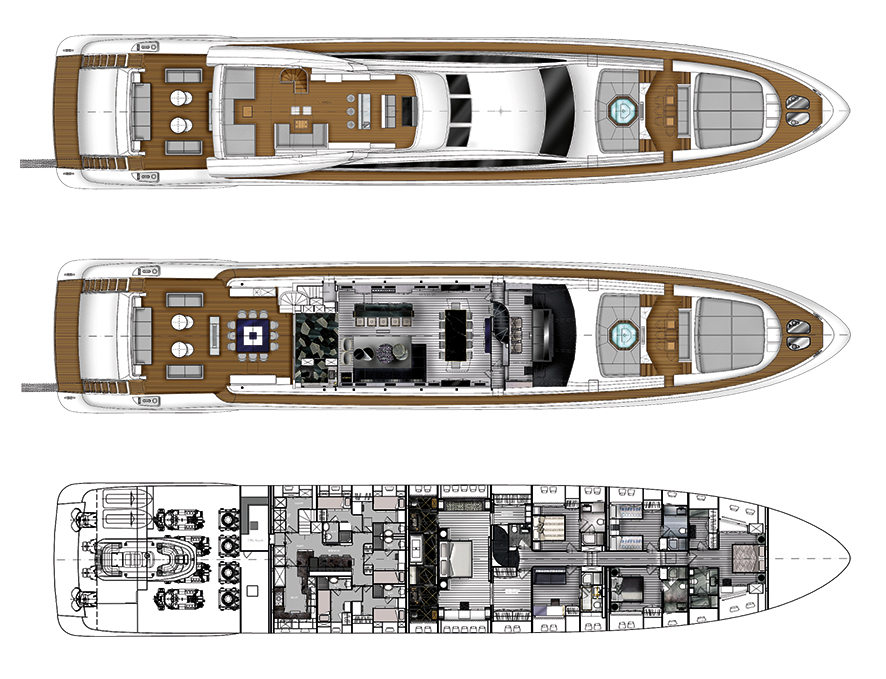
Eslora total | length overall: 49,9 m
Manga | beam: 9,2 m
Calado máx. | max draft: 1,9 m
Desplazamiento total | displacement at full load: 285 t
Desplazamiento media carga | half load displacement: 265 t
Capacidad de combustible | fuel capacity: 40.000 l
Capacidad de agua | water capacity: 4.000
Motorización principal | main engines power:
4 x MTU 16v 2.000 M94 1939 kw
Tranmisión | transmission: kamewa 2 x 71 s4 + 2 x 71 b4
Estabilizadores | stabilizers: 4 x seakeeper 35
Velocidad máx. | max speed: 37 nudos
Autonomía a velocidad de crucero | range at cruising speed:
(20 knots) 900 nm
Diseño exterior | Exteriors: Stefano Righini
Diseño interior | interiors: Maxine Tissenbaum
Constructor: Overmarine Group – www.overmarine.it
Importador: Michl Marine – www.michlmarine.com/es